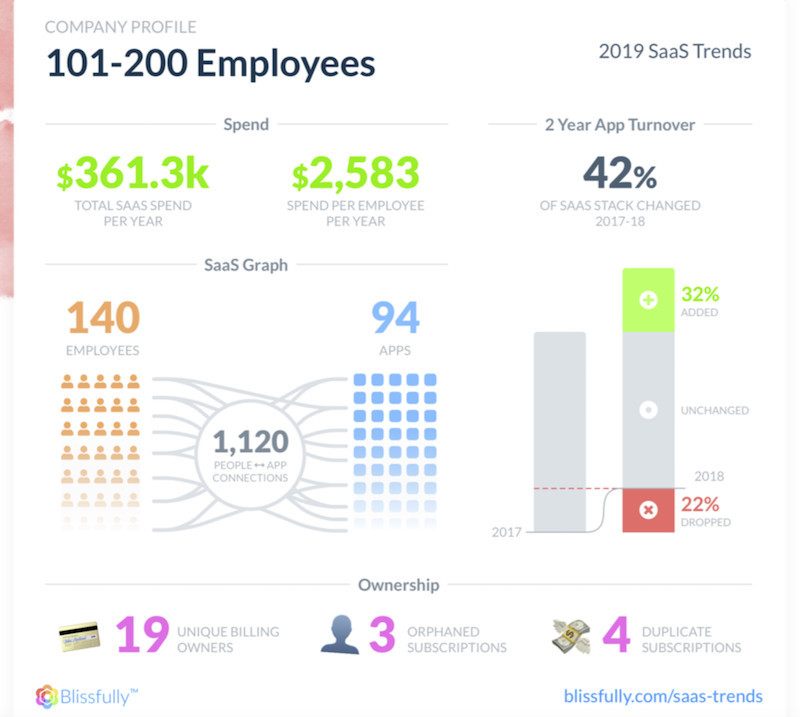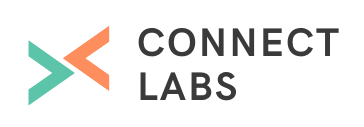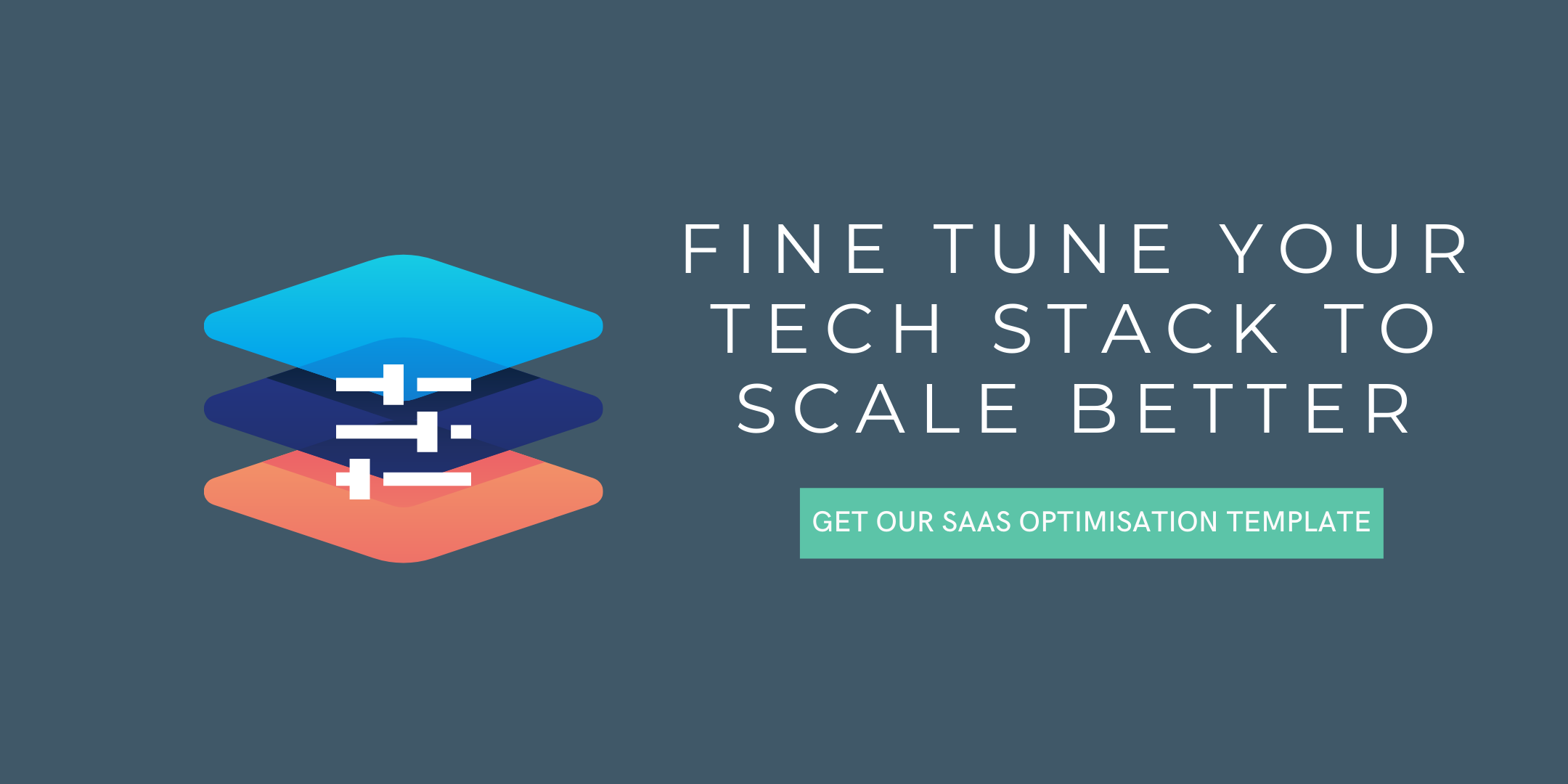If you think back ten, even five years ago, the needs of B2B businesses used to be much simpler. They had a website and email. Then they generally used a spreadsheet or document or two to keep track of leads, customers, subscriptions, and so on. Well, not anymore.
Have you ever heard the saying ‘Too much of a good thing’? It means that even something that is desirable or beneficial can be detrimental or negative in excess. It applies to many scenarios - cars, exercise, chocolate (ugh) and in today’s world, SaaS.
According to a marketing study by Chiefmartec research, there were 6,832 SaaS companies in the marketing industry alone in 2018. That means that a marketing team has nearly 7,000 software tools to choose from. Whoa. Or consider this graph from Blissfully from 2019 to see how a company uses apps and what sort of waste can arise from orphaned subscriptions.

Companies that experienced rapid growth meant that they had more customers which may also mean more employees, requiring even more programs - like human resources software, project management software and communication and collaboration tools.
With customer expectations came marketing automation, live chat apps, social media tools and smart content, just to name a few. As customers gre so did their needs to support them. This meant employing a customer relationship management (CRM) tool to better manage and grow relationships, a marketing tool to reach more customers, a sales tool to track deals and an accounting tool to manage revenue.
It’s been a very understandable snowball effect, and initially, all this SaaS software helped companies grow fast, connect with customers and support their employees to do their jobs.
At some point in recent years though, it’s become a bit...too much. This saturation of solutions has highlighted key issues faced by companies.
Companies are often paying for hundreds or even thousands of software tools but they are being
under-utilised.
A recent survey revealed that CIOs at the average large enterprise believe their companies are paying for 30 to 40 cloud apps, when it’s really closer to 1,000. This isn’t by any means unbelievable when you think about how easy it is to purchase new apps and tools. The issue is with this volume, companies aren’t seeing the return on their investment - and the effort to review what tech is being used and train people on using it is not being made nor is it being made anyone’s responsibility to manage. The purpose of software tools is to businesses function more efficiently and grow - the truth is though that too much tech can actually hinder growth by making things too complicated.
Data between systems often don’t line up.
For a company to operate effectively, data between systems needs to be consistent and when too many tools are used, this often doesn’t happen. This is because for the data to consistent across all systems, companies either have to have an integration in place for that to happen automatically or a process in place to ensure it happens manually - and these are often not considered when investing in a new software tool. There’s also a lack of emphasis on routine data maintenance, which requires having a schedule and process to check that integrations are working properly and/or data across tools is accurate.
People need to be trained on SaaS, but this isn’t happening.
A new client recently told us that for marketing, they have HubSpot Marketing Pro as well as Mailchimp and Hootsuite. All great tools, but their purposes actually overlap. When we asked why, they explained that they started with HubSpot but then the two newest team members had used Mailchimp and Hootsuite previously so they were more familiar with them and decided to use them as well. If this sounds familiar, you’re not alone.
People generally are adverse to learning new software and ways of working. This is why training is so crucial. As was in this case, however, instead of training these two new team members, they invested in two new tools. SaaS software has a learning curve and companies need to arm themselves with the resources and expertise to help their people learn the ropes.
Optimising your SaaS
B2B businesses could avoid tech overload and lack of ROI by getting strategic about their software and building an organised tech stack.
An organised tech stack will give a clear view of all the technology a company uses and the relationships between those tools and their critical business functions, not to mention the investment being made in each tool. Having a central and shared understanding of the technology being used at a company can help unite teams, eliminate data silos and ensure it is truly experiencing value.
There are a few steps to take to optimise or fine tune your tech stack.
Step 1: Review your current state of technology
Enlist all the teams and people within your company to make a list of all the apps/pieces of software they use regularly and how they are integrated or connected to each other, if at all. You also should capture:
- Billing owner
- How the tool is being used/its purpose
- Total number of users
- What metrics it provides
- Annual cost
Additionally, at this time, you want to assess the key stakeholders involved in the next step: analysing and evaluating. These stakeholders could include the people who first bought the software, those who are most knowledgeable of your existing tech stack, your leadership team and of course, those who actually use the tools.
This isn’t an overnight process, especially if you’re a larger company (in fact, it could take a few months), but it’s a worthwhile one.
Step 2: Analyse & evaluate your current state
Now that you’ve audited your tech, it’s time to review it. It’s likely you will find that teams are using different tools to serve the same purpose, or there is a gap with keeping data valid between one tool and another, or one that is frustrating and all too common, a team is using one piece of software for only one feature even though it’s a robust platform. While this might be a shock, the good news is now you have a full view of what’s happening, so you can make changes. In consulting with key stakeholders, you can work to eliminate unnecessary tools and fill those gaps.
.png?width=601&name=Considerations%20when%20evaluating%20software%20(1).png)
Step 3: Align your teams with your tech stack
In reviewing your existing software situation and the gaps and overlap, it often becomes quite clear that teams aren’t aligned. If they were, they could be using the same tool for their purposes or start using a different tool altogether that would make things easier. In strategically managing your technology, you can structure your teams and people around the software you use, achieving accountability and collaboration across teams.
Achieving total visibility of your technology ecosystem and furthermore, cleaning up your ecosystem will feel better and more freeing than spring cleaning. While taking the steps to fine tune (or fully renovate) your tech stack, remember to keep in mind the big picture - your business objectives and strategy. In doing this, you’ll often realise the complexity that too much software creates for your business is getting in the way of where you want to be.
The goal is to piece together the best mix of software for your business to operate efficiently, for your employees to be supported, for your customers to have a positive experience with your brand and for you to keep growing.
Tags:
B2B SaaS
April 26, 2021

